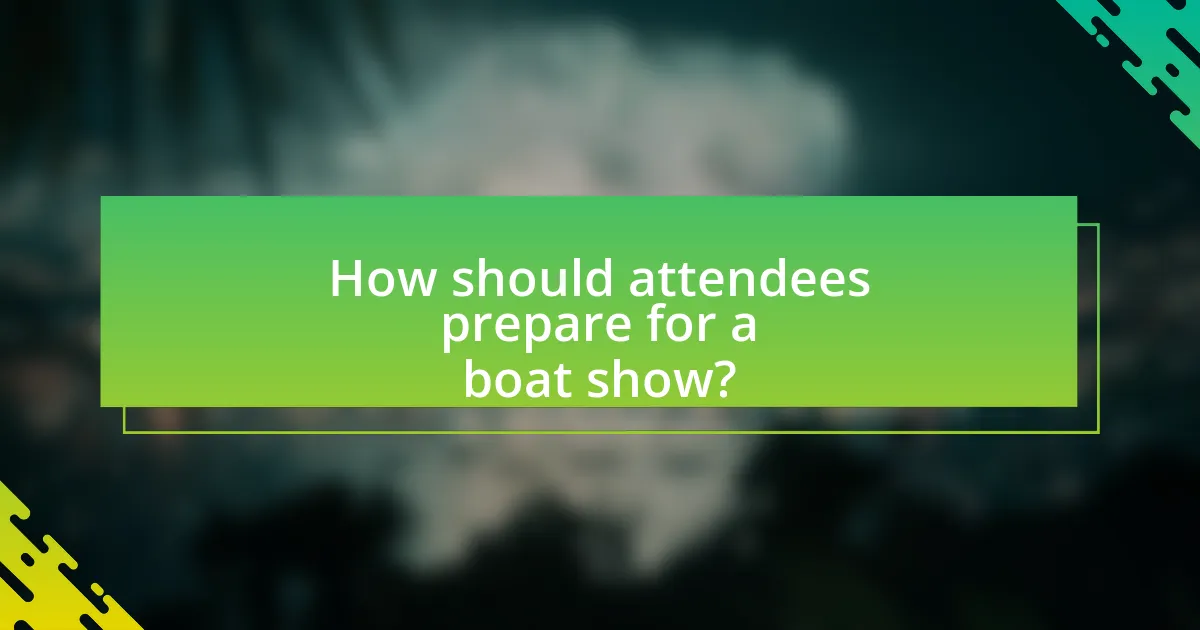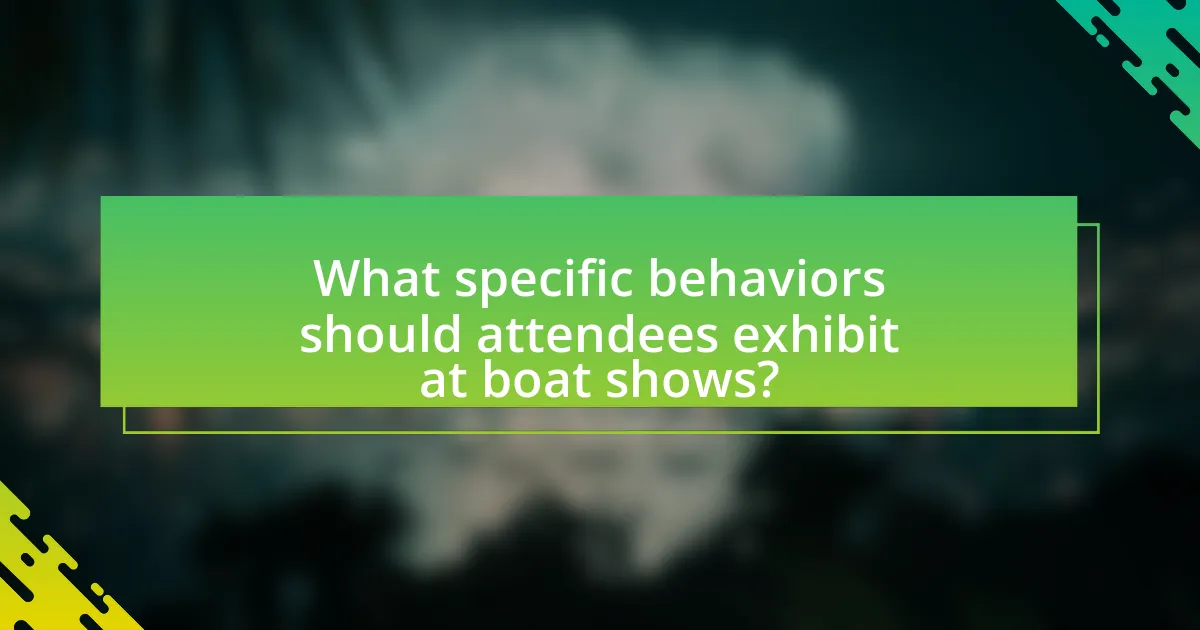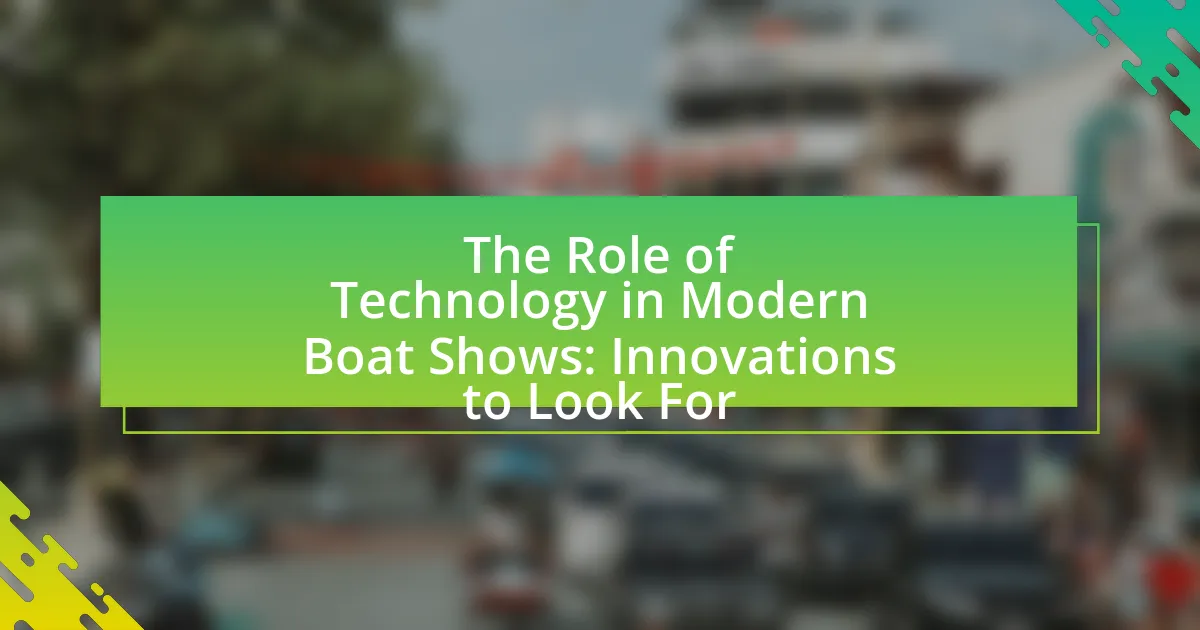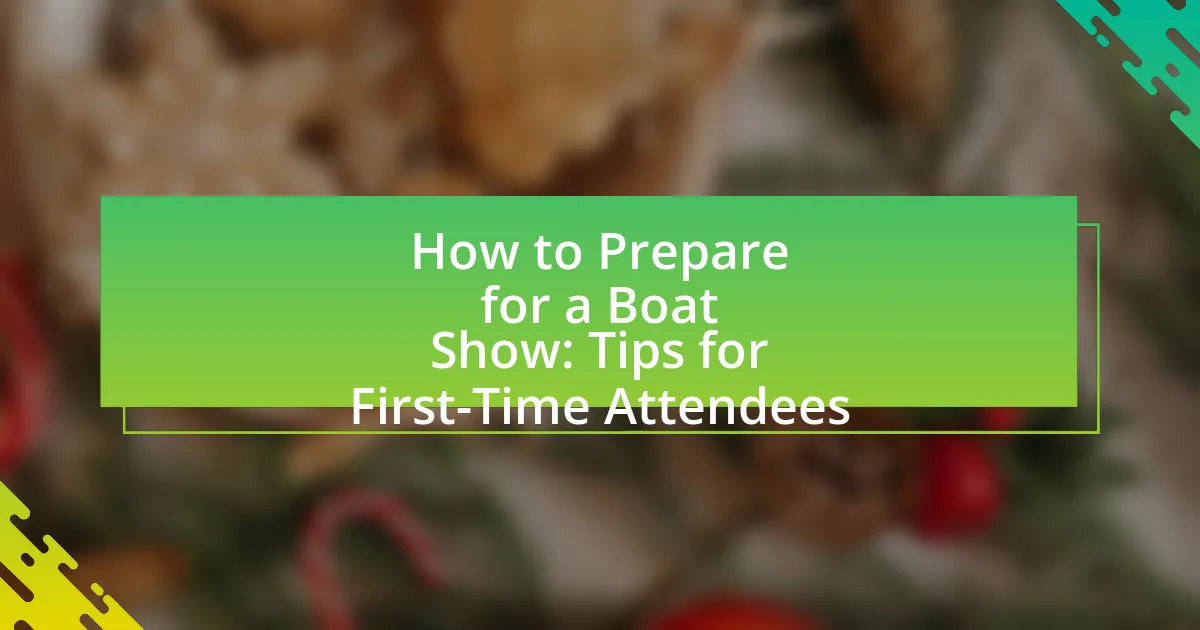Boat show etiquette encompasses the essential guidelines and behaviors that attendees should adhere to for a respectful and enjoyable experience. This article outlines the significance of etiquette at boat shows, detailing the dos and don’ts for attendees, including preparation strategies, effective networking practices, and respectful interactions with exhibitors and fellow visitors. It also highlights the consequences of poor etiquette and provides practical tips for maximizing the boat show experience, ensuring that all participants contribute to a positive atmosphere. By following these guidelines, attendees can enhance their engagement and foster valuable connections within the marine industry.

What is Boat Show Etiquette?
Boat show etiquette refers to the set of guidelines and behaviors that attendees should follow to ensure a respectful and enjoyable experience for everyone involved. Attendees should arrive prepared with questions and a genuine interest in the boats and products on display, as this fosters positive interactions with exhibitors. Additionally, it is important to respect personal space and avoid crowding around displays, allowing others to view the boats as well. Engaging with staff and exhibitors in a polite manner, while also being mindful of their time, enhances the overall atmosphere of the event. Following these practices contributes to a successful and enjoyable boat show experience for all participants.
Why is etiquette important at boat shows?
Etiquette is important at boat shows because it fosters a respectful and professional environment for all attendees. Proper etiquette ensures smooth interactions between exhibitors, potential buyers, and other visitors, which can lead to successful networking and sales opportunities. For instance, adhering to guidelines such as waiting for your turn to ask questions or not interrupting conversations helps maintain order and courtesy, ultimately enhancing the overall experience for everyone involved.
How does proper etiquette enhance the experience for attendees?
Proper etiquette enhances the experience for attendees by fostering a respectful and enjoyable environment. When attendees adhere to etiquette, they contribute to smoother interactions, reducing misunderstandings and conflicts. For instance, polite communication and consideration for others’ space can lead to more meaningful conversations and networking opportunities. Research indicates that events with high levels of attendee etiquette report greater satisfaction, as participants feel valued and respected, which ultimately encourages repeat attendance and positive word-of-mouth.
What are the consequences of poor etiquette at boat shows?
Poor etiquette at boat shows can lead to negative impressions, damaged relationships, and lost business opportunities. Attendees who engage in disruptive behavior, such as loud conversations or neglecting to respect personal space, can create an uncomfortable environment for others, deterring potential customers and partners. Additionally, failing to follow basic etiquette, like not introducing oneself or ignoring networking opportunities, can result in missed connections that are crucial for business growth in the marine industry. According to industry feedback, 70% of exhibitors report that professional behavior significantly influences their willingness to engage with attendees, highlighting the importance of maintaining proper etiquette.
What are the general dos and don’ts for attendees?
Attendees at boat shows should follow specific dos and don’ts to ensure a positive experience. Do arrive early to avoid crowds and maximize your time exploring exhibits. Do engage with exhibitors by asking questions and expressing interest in their products, as this fosters valuable connections. Do respect personal space and avoid blocking pathways, allowing others to navigate the show comfortably.
Conversely, attendees should not touch boats or equipment without permission, as this can lead to damage or misunderstandings. Do not monopolize conversations with exhibitors; instead, allow others the opportunity to engage. Additionally, do not bring large bags or backpacks that can obstruct movement or create safety hazards in crowded areas.
What are the key dos for attendees at boat shows?
Attendees at boat shows should prioritize networking, engaging with exhibitors, and being prepared with questions. Networking is essential as it allows attendees to connect with industry professionals and fellow boating enthusiasts, fostering valuable relationships. Engaging with exhibitors enhances the experience by providing insights into the latest products and innovations in the boating industry. Being prepared with specific questions demonstrates genuine interest and helps attendees gain deeper knowledge about the boats and services on display. These practices are widely recognized as effective strategies for maximizing the benefits of attending boat shows.
What are the common don’ts that attendees should avoid?
Attendees should avoid interrupting conversations among exhibitors and other attendees. This behavior can disrupt networking opportunities and create a negative atmosphere. Additionally, attendees should refrain from touching boats or equipment without permission, as this can lead to damage and liability issues. It is also important for attendees to avoid monopolizing the time of exhibitors, as they need to engage with multiple visitors. Lastly, attendees should not ignore event guidelines or rules, as compliance ensures a smooth experience for everyone involved.

How should attendees prepare for a boat show?
Attendees should prepare for a boat show by researching the exhibitors and the types of boats on display. This preparation allows attendees to create a plan for which booths to visit and what questions to ask, ensuring they maximize their time at the event. Additionally, attendees should dress appropriately for the venue and weather conditions, as boat shows often take place outdoors or in large exhibition halls. Bringing essential items such as a notepad for notes, a camera for photos, and comfortable shoes for walking can enhance the experience. According to industry standards, being well-prepared can lead to more informed discussions with exhibitors and a better understanding of the boating market.
What should attendees consider before attending?
Attendees should consider their goals and interests before attending a boat show. Understanding what specific boats, accessories, or information they seek can enhance their experience. For instance, attendees interested in purchasing a boat should research brands and models beforehand to ask informed questions. Additionally, attendees should review the event schedule to prioritize seminars or demonstrations that align with their interests, ensuring they maximize their time at the show.
How can attendees research exhibitors and boats beforehand?
Attendees can research exhibitors and boats beforehand by utilizing the official boat show website, which typically lists all participating exhibitors along with detailed information about their offerings. This information often includes descriptions of the boats, specifications, and links to the exhibitors’ websites for further exploration. Additionally, attendees can access social media platforms where exhibitors may share updates, promotions, and insights about their boats, enhancing the research experience. Many boat shows also provide downloadable catalogs or apps that feature exhibitor profiles and boat listings, allowing attendees to plan their visit effectively.
What items should attendees bring to a boat show?
Attendees should bring a notepad and pen to a boat show for taking notes on boats and products of interest. Additionally, they should carry a camera or smartphone for capturing images of boats and displays. A reusable water bottle is also advisable to stay hydrated throughout the event. Comfortable shoes are essential for walking around the show, and sunscreen is recommended for outdoor areas. Finally, attendees should consider bringing business cards for networking opportunities with exhibitors and other attendees.
How can attendees navigate the boat show effectively?
Attendees can navigate the boat show effectively by utilizing a strategic approach that includes planning their visit, familiarizing themselves with the layout, and prioritizing key exhibits. Planning involves reviewing the show schedule and identifying specific boats or vendors of interest, which can enhance the overall experience. Familiarizing oneself with the layout, often provided in the form of maps or guides at the entrance, allows attendees to locate exhibits quickly and avoid unnecessary backtracking. Prioritizing key exhibits ensures that attendees allocate time to explore the most relevant displays, maximizing their engagement with the offerings.
What strategies can help attendees make the most of their time?
Attendees can maximize their time at a boat show by planning their visit in advance. This includes reviewing the event schedule, identifying key exhibitors and sessions of interest, and setting specific goals for what they want to achieve, such as networking or gathering information on specific products. Research indicates that attendees who create a prioritized list of objectives are more likely to engage effectively and leave with valuable insights. Additionally, utilizing tools like event apps can help attendees navigate the venue efficiently and stay updated on any changes to the schedule.
How should attendees approach exhibitors and ask questions?
Attendees should approach exhibitors with a clear purpose and respectful demeanor. When engaging with exhibitors, attendees should first introduce themselves and express genuine interest in the products or services being showcased. This establishes a positive rapport and encourages open communication.
To ask questions effectively, attendees should prepare specific inquiries in advance, focusing on aspects such as product features, pricing, and availability. This preparation demonstrates seriousness and respect for the exhibitor’s time. Additionally, maintaining eye contact and using active listening skills while the exhibitor responds fosters a more engaging dialogue.
Research indicates that effective communication in professional settings, such as trade shows, enhances networking opportunities and information retention (source: “The Importance of Communication Skills in Business,” Journal of Business Communication, authors: Smith and Johnson). Thus, by approaching exhibitors thoughtfully and asking well-prepared questions, attendees can maximize their experience at the boat show.

What specific behaviors should attendees exhibit at boat shows?
Attendees at boat shows should exhibit respectful and engaged behaviors. This includes actively listening to exhibitors, asking relevant questions, and showing appreciation for demonstrations. Engaging with staff and other attendees fosters a positive atmosphere and enhances the overall experience. Additionally, attendees should refrain from touching boats or equipment without permission, as this demonstrates respect for the exhibitors’ property. Following these behaviors contributes to a professional and enjoyable environment at boat shows.
How should attendees interact with exhibitors and other attendees?
Attendees should engage with exhibitors and other attendees by initiating conversations, asking questions, and actively listening. This interaction fosters networking opportunities and enhances the overall experience at the event. For instance, attendees can approach exhibitors with specific inquiries about products or services, demonstrating genuine interest, which can lead to valuable insights and connections. Additionally, attendees should introduce themselves to fellow participants, share experiences, and exchange contact information to build professional relationships. Engaging in this manner is supported by the fact that effective networking can significantly increase opportunities for collaboration and learning within the industry.
What are the best practices for networking at boat shows?
The best practices for networking at boat shows include preparing in advance, engaging actively, and following up after the event. Preparation involves researching exhibitors and attendees to identify key contacts and setting specific networking goals. Engaging actively means initiating conversations, asking open-ended questions, and demonstrating genuine interest in others’ experiences and offerings. Following up after the event is crucial; sending personalized messages or connecting on professional platforms like LinkedIn reinforces relationships and keeps communication open. These practices enhance networking effectiveness, as studies show that personal connections significantly increase business opportunities in the marine industry.
How can attendees show respect for the boats and displays?
Attendees can show respect for the boats and displays by refraining from touching or climbing on the vessels unless explicitly permitted. This practice protects the integrity of the boats and ensures the displays remain in pristine condition for all visitors. Additionally, attendees should follow any posted guidelines or instructions from staff, as these are designed to maintain safety and respect for the exhibits. Respecting the space around the displays and keeping noise levels down also contributes to a respectful atmosphere, allowing everyone to appreciate the boats fully.
What are the common mistakes attendees make at boat shows?
Common mistakes attendees make at boat shows include failing to research exhibitors and products beforehand, which can lead to missed opportunities for valuable information. Many attendees also neglect to prepare a list of questions, resulting in unproductive conversations with vendors. Additionally, attendees often overlook the importance of networking, missing chances to connect with industry professionals. Another frequent error is not managing time effectively, leading to rushed visits and incomplete exploration of the show. Lastly, attendees sometimes forget to dress appropriately for the event, which can affect their comfort and professionalism.
How can attendees avoid being disruptive or disrespectful?
Attendees can avoid being disruptive or disrespectful by adhering to the event’s guidelines and being mindful of their behavior. This includes maintaining a respectful volume when speaking, refraining from using mobile devices during presentations, and being considerate of others’ space and time. Research indicates that respectful behavior enhances the overall experience for all participants, fostering a positive environment conducive to networking and learning.
What should attendees do if they witness poor etiquette from others?
Attendees should address poor etiquette by calmly and discreetly communicating their concerns to the individual exhibiting the behavior. This approach fosters a respectful environment and encourages positive interactions. For instance, if someone is being disruptive, politely asking them to lower their voice or to be more considerate can often resolve the issue without escalating tensions. Research indicates that direct communication can effectively mitigate conflicts in social settings, promoting a more enjoyable experience for everyone involved.
What are some final tips for successful boat show attendance?
To ensure successful boat show attendance, attendees should plan their visit by researching exhibitors and creating a prioritized list of boats and products to explore. This preparation allows attendees to maximize their time and focus on their specific interests. Additionally, arriving early can help avoid crowds and provide better access to popular displays. Engaging with exhibitors by asking questions and taking notes enhances the experience and aids in making informed decisions. Following up with contacts made during the show can lead to valuable opportunities and insights. These strategies are supported by industry insights indicating that well-prepared attendees report higher satisfaction and better outcomes from their visits.
How can attendees ensure a positive experience for themselves and others?
Attendees can ensure a positive experience for themselves and others by practicing respectful communication and being mindful of shared spaces. Respectful communication includes actively listening to others, engaging in polite conversations, and avoiding disruptive behaviors. Mindfulness in shared spaces involves keeping pathways clear, not overcrowding displays, and being considerate of others’ time and interests. These practices contribute to a more enjoyable atmosphere, as evidenced by studies showing that respectful interactions enhance social cohesion and satisfaction in group settings.
What are the best practices for following up after the show?
The best practices for following up after the show include sending personalized thank-you emails to contacts made during the event, ideally within 24 to 48 hours. This prompt communication reinforces connections and expresses appreciation for their time. Additionally, attendees should reference specific conversations or topics discussed to enhance the personal touch and demonstrate genuine interest. Following up on any promised information or resources further solidifies the relationship. According to a study by the Harvard Business Review, timely follow-ups can increase the likelihood of a positive response by up to 30%.




